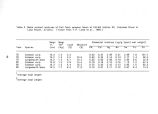| OCR Text |
Show of operation ( other than for tar sands), prospecting permits, or special use permits for mineral operations are pending. Forty- seven over- the- counter lease offers for approximately 130,000 acres are being evaluated on a case- by- case basis by the BLM. Currently there are 34 suspended federal oil and gas leases encompassing 38,000 acres in the Tar Sands Triangle and Purple Hills areas. Thirty- one of the 34 leases are being evaluated for conversion to " combined hydrocarbon" leases. Surface disturbances associated with oil and gas development may result in increased runoff and erosion. If an area can support production, surface disturbance could affect recharge areas for springs and seeps. Produced hydrocarbons, process fluids, and liquid wastes could enter local drainages due to spills and ultimately enter Lake Powell. Another potential water resource impact from oil field development stems from road construction, which often increases sedimentation rates in affected watersheds. Should the operation require settling and surge/ storage ponds, overflows and leaks could occur that would affect surface water resources. In addition, local degradation of shallow ground water could result from impacts occurring in the surface recharge areas. Any impact on available water, whether through diminished flows or degraded quality, is considered serious. Drilling can produce brine waters from each of several formations within the recreation area. Brine can contaminate aquifers if not properly sealed downhole. Concrete plugs must be placed both above and below the aquifer to protect the water- bearing zone. When downhole pressure occurs, contaminated water blow- out could follow. This could result in severe surface and subsurface impacts, especially if brine is emitted. During the oil and gas production phases, leakage or spills can occur as a result of transportation and handling in trucks and pipelines. On- site product upgrading also produces water that must be reinjected or transported to a designated disposal site. The final stages of petroleum recovery may pose additional water resource impacts. Secondary recovery utilizes techniques involving horizontal subsurface fracturing and enhanced recovery programs driven by steam, water, or other agents. These procedures could establish communication with aquifers and recharge areas for springs and seeps. Resulting impacts may include contamination of aquifers and spring areas but also includes elimination of surface water sources. To evaluate the potential for such effects when considering mineral lease applications, accurate information on water resources in the area of concern is needed. Currently this information is inadequate. 55 |








































































































